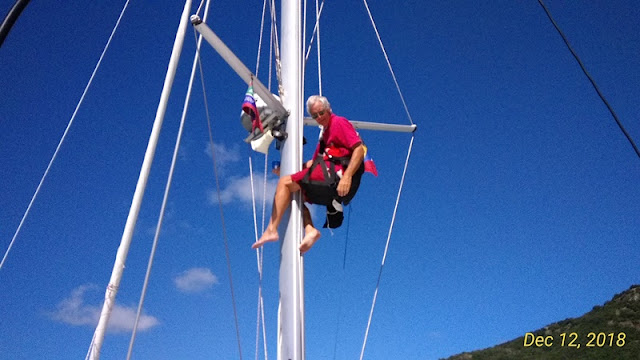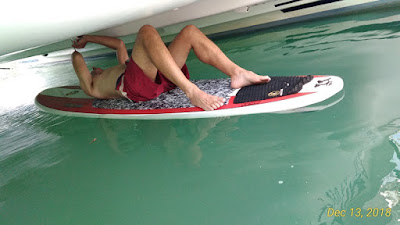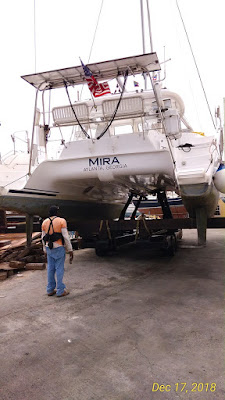
More boatyard blues on Mira, in the Antigua Slipway yard. Jason going up the mast to replace some rusted bolts on the hailer while checking rigging. He made several trips up and down to fix things or make improvements on the boat.
One of the many butterflies that seemed to get caught behind Mira's windshield.
Jason had to borrow a surfboard from a fellow boater to get under Mira to remove the clam shell coverings on the hulls. There wasn't enough room to get under the boat in the dinghy.
The surf board had to be positioned between the dock lines to get onto it.
It was an awkward boarding, but Jason managed not to dump himself or any tools.
A floating work platform for this job. Getting them off ahead of time gave me the chance to clean them all up.
The riggers and Jason discussing how far back the mast is raked.
A frangipani caterpillar, climbing all over the yellow flowered bushes at the marina. They are as fat as my finger and as long as my hand. Plump, colorful fellows, but they cause a lot of foliage damage. The egrets will eat them, but they don't come to this corner of the marina so the bushes here were decimated in a matter of days. The caterpillars bury themselves in the dirt and emerge later as big brownish/grey sphinx moths.
Jason looking at the caterpillars.
Note the long stinger on the back end. I doubt they could hurt you, but they are toxic to birds after eating the leaves and sap of their host plants.
An old hat stuck on a corner of an old door or window in a building in the boatyard.
These megayachts in Nelson's Dockyard must have divers lift their anchors so they can leave. They drop two anchors to hold their bows in place when they dock stern-to. There isn't a lot of room for each boat to put anchors out in a big V pattern, so they just drop them wherever they need to and have divers pick them back up so they don't snag another's anchor.

The divers use big inflatable salvage bags to lift the giant anchors off the seabed. It's a slow process so these megayachts can't leave in a hurry. The dive teams are in high demand some days and the yachts have to wait their turns to be able to leave.
Jason slaking his thirst as we were tied along the fuel dock next to the boatyard.
The controls of the lift come all the way out into the water. The driver also dives under the water to make sure the lifting beams get placed properly to avoid damage to the props and shafts.
The tug that pulls the boat once it is near land has a dead battery and must be jumped each time it is used.
A photo shot looking up the rudder post catches Karen's face upside down. Puddles of rusty water dripped out of the rudders and I didn't think that was a good thing.
Jason and the riggers working on the main furling system. They took a lot of slack out of the internal extrusion to help the mainsail furl better.
Jason working on his spreadsheets to provide information about what was being done. He did a lot of work on Mira and was trying to keep track of it all for the owners.A view from the boat while at the marina dock. A big palm in silhouette against the setting sun in Falmouth Harbor.
Jason taking us along the coast once the weather calmed a bit after the holidays.
Mira at the fuel dock just before being hauled out at the Antigua Slipway.
Two megayachts pass each other just off our stern in Nelson's Dockyard. A lot of money floated by each day here.
The man running the controls to raise Mira onto the lift. He has the bow lines in one hand trying to control the front of the boat, while another worker onboard is controlling the back end, which is tied to a pillar in the water. The men took half a day to get the boat positioned safely onto the beams to lift us out of the water. They had to check underwater to make sure we got positioned properly.
Pulling on the cable used to reel us in. He kept the boat centered where he wanted it to get it close enough to then use the little tug to pull us out of the water on the trailer.
Notice the wheel of the little tug vehicle is barely missing the pit of green water.
Mira getting to her spot in the boat yard.
It took four men to muscle the beam in place for Mira to rest on.
A big steel boat being hauled the next day needed an extra support beam welded onto the metal sled. The boatyard had to hire in a forklift to get this beam in place.
A yard worker uses an old-fashioned Spanish windlass to twist a rope to tighten the support beams and pull them together from both sides of the boat.
We spotted this lion fish just off the dock of the pizza place next to the boatyard.
Jason waiting for his pizza.
Karen waiting for her pizza. It was two-for-one pizza night and we were hungry from working on the boat in the yard behind me.
We spotted another Antares catamaran across the water at Nelson's Dockyard. It's the one to the left of the green behemoth. The 44' Antares looks tiny when compared to the other yachts at the dock.
Jason heading off for another trip to Budget Marine for supplies for the boat projects. The local chandlery was pathetic when it came to customer service and supplies; Jason had to make the trip to the local store every single day to try to get the items he needed to complete some projects for the boat.
The steel yacht was powerwashed and this blood red pool was the result.
The boatyard then siphoned off the water pit and pumped the toxic water right into the bay off the lifting ramp. I was horrified. A yard doing this in the US would get it shut down and fined by the EPA.
This red water only lasted one day. Mother Nature apparently took care of it overnight.
The boatyard hung huge tarps between Mira and the steel yacht to try to minimize the red dust and steel grindings that would stain Mira. The wind caught the tarps on the sharp corners of the rusty steel I-beams and ripped the tarps to shreds in a matter of hours. The yard had to suspend work until they could get us launched--an added incentive for them to complete our work.
Jason working on fixing the anti-siphon system for the engines on Mira. The hoses were installed too low and would let damaging seawater into the engines in rough seas, so he raised the hoses on both engines while we were on the hard.
Jason updating his spreadsheet where he documented his activities and expenses for the owners.I cleaned the props and shafts and line cutters and put the zincs and line cutters back onto the shafts. Clean and shiny again.
Mira had to be manouvered around the end of the steel yacht to get back into the water. It was a very tight fit and the man driving us said he only had one shot to get it right. No room to turn around without hitting something.
The folks on the steel yacht are hanging over the end of their stern watching Mira pass below them to get launched.
Fire (his nickname) got Mira out and back in without any incidents. He handled lines, electronic controls and the tug to get his job done. He also got into the water to make sure it was all right.
Mira hits the water on re-launch. We took the dinghy from the shore to board the boat once it floated.
Fire swims out to make sure Mira gets off the lifting sled completely so we could leave. We were in and out in five days, a record time for getting any work done in a boatyard the week before Christmas in the Caribbean.




















































No comments:
Post a Comment